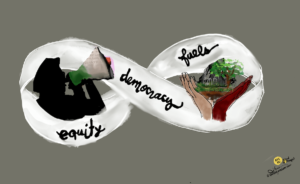What Will it Take To Achieve Equity in Education?

By: Jessica Reid Sliwerski
“Until we get equality in education, we won’t have an equal society.” That was Supreme Court Justice Sonia Sotomayor in 2009—more than a decade ago and 70+ years since the start of the Civil Rights movement. The disparity in educational equity has continued to widen, rather than shrink, in the decade since. Gaps in academic outcomes between high- and lower-income students have grown substantially. And it’s just not ok.
Eighteen years after “No Child Left Behind” promised to “close the achievement gaps” in race and socio-economic background, children in more than one-third of the nation are still underperforming in reading, writing, and math. Lackluster recent NAEP scores among 4th and 8th graders confirm this.
In many states, funding is the driving force behind education inequity. According to an analysis by the Education Law Center and Rutgers Graduate School of Education, school budgets vary dramatically and are usually dictated by local property taxes. This often leads to “less funding in higher poverty school districts, even though these students may require more resources to achieve.” (Federal funding, on average, accounts for 10% of a district’s budget.)
Even more alarming: “The worst-funded states also tend to neglect the basic educational interventions that could close the gaps in academic performance by underfunding early-childhood education,” according to TheNation.com. Compounding the problem are low student-to-faculty ratios, overworked teachers, and curricula inadequate for meeting basic state standards. The result: Consistent “underperforming” ratings for poorer districts. Students of color are disproportionately affected, with approximately 40 percent of these young people attending high-poverty schools (defined as 75 percent or more of students receiving free or reduced-price lunch).
Disparities persist throughout the educational careers of low-income children, starting with a substantial achievement gap in kindergarten-readiness. If a child cannot read by the time they are in third grade, they are four times less likely to graduate high school; add poverty to the mix and a child is thirteen times less likely to graduate.
The long-term effects are startling. Missed educational opportunities trap young people in the cycle of generational poverty. Extensive research has conclusively shown that lower educational attainment is associated with diminishing employment prospects, stagnant wages, increased incarceration, and an untrained labor force unable to meet the demands of today’s global job market. This is a degradation of our American values. In order for our democracy to flourish, and prepare future generations for a global economy, the promise of life, liberty, and the pursuit of happiness cannot be held exclusively for those born into privilege of native-language, learning abilities, skin color, and socio-economic status.
Let’s Level The Playing Field
A special report by the Economic Policy Institute notes that while the total share of income claimed by the bottom 90 percent of Americans has steadily decreased, the majority of income gains are going to the top one percent. “These trends would not be such a major concern,” the report states, “if our education system compensated for these inequities by helping level the playing field and enabling children to rise above their birth circumstances.”
A 2016 national study of school finance reforms found that children from low-income families residing in states that spent 20% more on education over their 12 years of school experienced 23% higher graduation rates than similar children without this benefit. These advantages carried on in later life, ultimately eliminating the gap in adult poverty rates between them and their more affluent peers. Education is the single most effective strategy our country has for eliminating poverty. But what of the states that simply do not have the funds?
There are many theories on how equity needs to be addressed in K-12. Overwhelmingly, the students without access to high-quality curriculum, classrooms, technology, and consistently-trained teachers suffer the most. The pain for schools is figuring out where to start while already feeling defeated. These schools need access to affordable, high-quality curriculum and professional learning for their teachers for implementation support and success.
This failure is preventable for virtually all children. A 2017 report by bipartisan education advocacy group Chiefs for Change highlighted the extensive research demonstrating the impact of high-quality curriculum on student outcomes, noting, “Investments in curriculum components are highly scalable, and effects are greatest with weaker teachers, who are disproportionately present in high-need classrooms.” More recently, the Center for American Progress found “the effect size of a strong curriculum is larger than that of many other common education reform efforts.” If schools have greater access to high-quality curricula and practices, it could be possible to reverse the continued fall in achievement of the nation’s lowest-performing schools, thus leading to a narrowing—perhaps even an elimination—of the achievement gap.
Offering hope and growing in popularity are open educational resources (OER). These cost-effective solutions provide freely accessible, openly-licensed curricula for teaching, learning, and assessment. Districts are free to use, customize, enhance, and redistribute materials for their unique student populations. In most cases, there is no charge, or only modest licensing fees. Expanded access to learning is then available to all, regardless of school system, income, zip code, or background.
However, it’s not enough to make curricula freely accessible. A quick Google search will show you a myriad of “free” resources with little promise of effectiveness and no implementation support. Curriculum needs to be evidence-based, thoroughly vetted, and supported with ongoing professional learning programs to help build teacher knowledge and confidence.
Open Up Resources (OUR), the organization I lead, is looking at the solution holistically by incubating and distributing top-rated OER while offering a variety of professional learning opportunities to ensure districts are set up for success and supported throughout their implementation—which, for most districts, takes years.
Across our curricula, educators around the country are seeing results. Seaford Public Schools (DE) have implemented Bookworms K-5 Reading & Writing. Once one of the lowest performing districts in Delaware, it now matches state performance, and its third-graders are significantly outperforming the state. In a diverse district that serves African American and white students and the children of relatively new immigrants from Haiti and Central America, these schools are now building ELA excellence.
Twelve schools across Northeast Georgia adopted our High School Math Curriculum and saw gains anywhere from 10% to 30% on End-of-Year assessments given by the state.
In Beaumont Middle School, Open Up Resources 6-8 Math supported them in a time of transition where they saw a 14% increase in minority students, a 17% increase in students receiving free lunch, a 12% increase in special education students, and a 28% increase in English Language Learners. Just a year after implementing OUR 6-8 math, 7th graders took the state-required state final exam and saw scores increase across the board. Among the highlights, the average score increased from 67% to 83%. The collaborative class—a co-taught class for students who have IEPs—was only 3% lower than the general ed class, virtually closing the achievement gap; and for the first time in over 13 years, there were no novice students in the collaborative class.
Inequity in education cannot be denied but solutions, like Open Up Resources, exist! The impact affects our country both now and in the future. The need to course correct is urgent. In Nelson Mandela’s words, “There can be no contentment for any of us when there are children, millions of children, who do not receive an education that provides them with dignity and honor and allows them to live their lives to the fullest.”
Therein lies the challenge. The opportunity to foster equality and fulfill our democracy’s founding promises stands before us.
For more, see:
- Getting Clearer: Building Equity in Schools
- Creating Culturally Linguistic and Responsive Classrooms: A Place Where All Kids Belong
- Open Up: High Quality Standards-Aligned Math Curriculum
Jessica Reid Sliwerski is CEO of the education nonprofit Open Up Resources. She is a published children’s book author and former teacher, district literacy coach, and Chief Academic Officer at an award-winning literacy company.
Open Up Resources is a 501c3 that exists to increase equity in education by making the highest quality curriculum freely accessible to educators and providing implementation supports to the broadest number of teachers, empowering them to effectively and sustainably improve student outcomes in pre-K-12 English Language Arts and Mathematics.






0 Comments
Leave a Comment
Your email address will not be published. All fields are required.